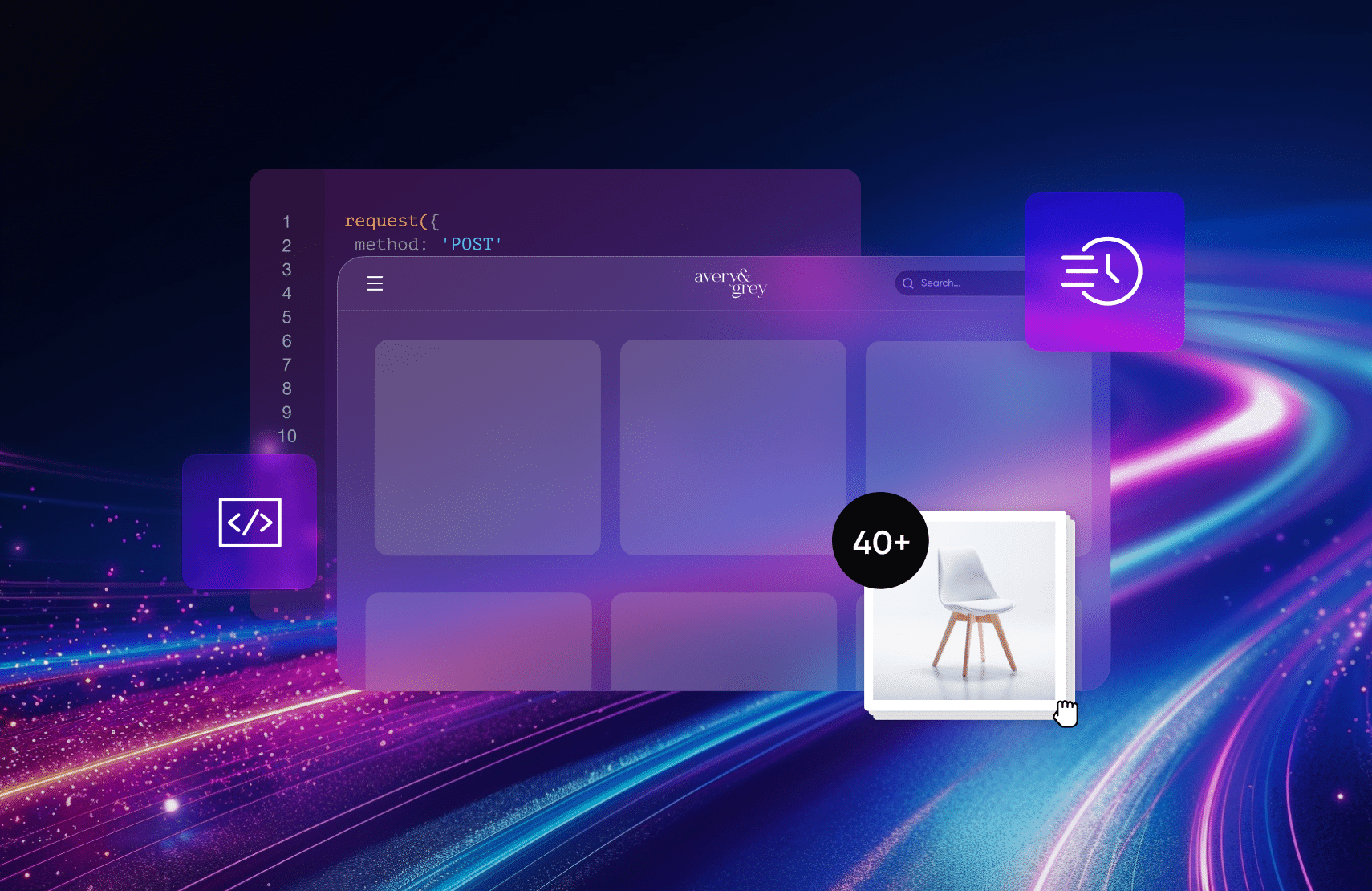Speed Does Matter: A Fast-Moving Platform for Fast-Moving Commerce

In the previous post, Never Miss A Sale, we announced the availability of order fulfillment logic (OFL) which allows retailers to orchestrate and optimize how your distributed order management (DOM) system works across the order fulfillment process, as part of fabric OMS. With this release, fabric is giving retailers a way to quickly outpace the traditional approaches for inventory and sourcing decisions.
The influence of AI and evolving social media shopping trends are accelerating the rate of change in the retail industry. As proof, Forbes lists the “rise of AI” and “social commerce” as two of the four major trends shaping retail this year. And, IDC predicts that 95% of retailers will invest in generative AI over the next three years.
As AI and generative AI increasingly identify advantages, trends and opportunities for both retailers and consumers, a merchant’s ability to adapt to a fast-changing market will become more critical.
A fast-moving commerce platform for fast-moving commerce
The challenge is how to bring a commerce solution that can react with enough speed to help you capitalize on these macro trends. This requires a solution that enables your retail business to be agile and adapt with speed while not breaking the trust contract you’ve made with customers as they make the buying decision.
fabric is uniquely positioned to solve this challenge through several strengths:
- Our core philosophy
- Unified real-time inventory insights
- Business-owned sourcing decisions
- Relevant alerts
Let’s unpack each of these fabric strengths.
Core Philosophy
How a platform provider defines its core philosophy provides insight into the product priorities and what problem the platform is solving. fabric is no different and we believe that:
- Speed matters. First, we strive to deliver industry-leading performance for our services. Every millisecond wasted in a storefront is a potential lost conversion. Second, time to value is critical. To survive, businesses need to achieve faster ROI than ever before.
- Configuration reigns over code. We aim to remove dependencies on traditional IT organizations and put control into the hands of the business operators.
- It must be easy. Managing a complex business easily and efficiently can only be achieved when the platform is intuitive and flexible.
Unified Real-Time Inventory Insights
Accurate and up-to-date inventory insights are the foundation of a good customer experience. One of the most critical metrics is the high rate of cancellations due to inventory inaccuracies. While not obvious, it ultimately undermines the trust a customer has in the retailer’s brand.
fabric’s inventory visibility takes a different approach to reduce customer cancellation rates. Unlike traditional models that use a data replication strategy between the backend order management and storefront caches, our platform takes a different approach. While this challenge was difficult to overcome, we believe that only one unified version of inventory data across all channels should exist to:
- Serve the same consolidated, accurate inventory availability of any location, vendor, or network to both storefronts and fabric OFL with industry-leading performance.
- Publish changes in real-time to third-party platforms (like social media, Shopify or Salesforce Commerce Cloud).
- Consume and update in real-time all inventory adjustment, reservation or receiving data from multiple sources including warehouses, stores and vendors.
To understand why this is so important, let’s look at a simple use case. Imagine that a customer purchased a limited quantity item on your website and decided to return it to a local store. As soon as the store employee processes the return, the transaction is sent to fabric OMS. Within seconds, the inventory availability is updated to show the item as available for both BOPIS and Ship from Store. It is then immediately available for the next customer to discover the item on social media or any other channel. With traditional data replication solutions, this new sale may have been lost due to the delay in replicating up-to-date inventory data between systems.
Aligned to our core philosophy, speed matters when it comes to conversions and customer satisfaction. It matters in two ways:
- Serving inventory availability at scale with industry-leading speed overcomes the challenge of reading and writing to the same data source.
- Processing inventory changes quickly reflects accurate positions for customer purchases and internal sourcing decisions.
Business-owned Sourcing Decisions
Retail business conditions are in a constant state of flux. The ability to ship packages to customers could be interrupted for a variety of reasons, such as weather conditions, labor shortages, shipping disruptions, limited inventory or customer complaints. Irrespective of the reason, the ability to quickly adjust how customer orders are sourced can be the difference between a satisfied or unsatisfied customer, or getting a repeat customer versus a one-time shopper.
Every OMS has a fulfillment or sourcing engine that operates the same fundamental way: a set of conditions, rules, and algorithms lead to a set of instructions about from which location to pick the product and how to ship it. Some are very simple and have a basic UI, while others can apply complex rule sets but have no UI, so the rules must be coded by the IT team.
At fabric, we set out to address both ends of this complexity spectrum by creating an OFL engine that can handle the most complex use cases while delivering it all through an intuitive UI for retail business operators.
What fabric OFL brings to retailers is a system that:
- Enables business operators to configure complex rulesets through a simple and powerful UI.
- Removes the need to rely on IT to make changes.
- Enables changes to be deployed within seconds.
- Builds on a set of APIs that can be leveraged by AI.
- Uses the same real-time inventory information that powers the storefront.
Aligned to our core philosophy, fabric OFL is managed by configuration, not code.
Relevant Alerts
Gone are the days of looking at static reports everyday to make sure your business is operating normally. With the onset of ubiquitous connectivity and mobile devices, the mindset has shifted from the need to seek out information to receiving customized alerts that draw your attention to relevant and important information.
With fabric OMS, there can be millions of orders, events, and actions occurring throughout a day. Trying to decipher what’s relevant can be difficult and overwhelming, but fabric makes it easy.
fabric’s custom alerts let you configure the business conditions important to you to filter out the noise while keeping you informed of critical insights. For example, you could configure an alert to inform a decision-maker when a West Coast warehouse is shipping less than X orders per hour. Or, you can configure alerts on when capacity limits have been met in more than Y% of stores. No matter what information is critical to your retail operations and business goals, a custom alert can be created.
The approach fabric took to solve the challenge of alerting is unique. fabric’s custom alerts feature sits outside the core OMS and acts like an observer. As events flow through the system, or data changes or becomes stagnant, the alert system notes what is happening and triggers alerts if a condition is met.
fabric custom alerts exist as a separate function because, as AI continues to automate more of your daily tasks, knowing what is occurring is key. Instead of replicating everything to a data platform to do the analysis and introspection, AI from any vendor or in any other system can easily interact with fabric in real-time using standard APIs to create helpful automation.
Never Miss a Sale
Winning with your retail customers starts with being transparent, accurate, and reliable. When a customer shops your storefront, you obviously want to display inventory availability with certainty, knowing that you have in stock what the customer is looking for, and that it is in the location that best meets their needs.
If some unforeseen event happens on your side, customers don’t care. You need to quickly adapt so you never break the trust you have built with your customers.
With fabric OMS, you have the tools to be there for your customers.
Next-Gen Retail: Crafting the Ultimate Omnichannel Journey
As we explore the intricacies of modern retail and the pivotal role of distributed order management systems and fabric OFL, the journey doesn’t end here. Join us for an exclusive webinar where real-world applications and visionary strategies come to life.
Join Jay Topper, Head of Strategy and Innovation at fabric, and Jennine Loisel, EVP of Technology at Bounteous x Accolite, as they delve into a comprehensive case study with a leading women’s fashion retailer. Discover firsthand how innovative strategies and a robust omnichannel approach led to a significant 30% lift in conversion rates and set new benchmarks in customer satisfaction and operational efficiency.
Don’t miss out on this opportunity to gain insights that could redefine your retail strategy and propel your business into the future. Reserve your spot today and start your journey towards a more dynamic and adaptive retail environment.
Embrace the future of retail with us. Let’s innovate together!

Product engineering @ fabric. Previously merchandising and application development @ Staples.
